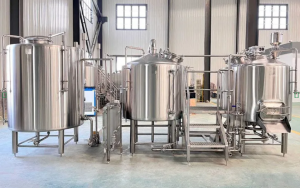
Commercial brewing is a complex and multifaceted process that transforms raw ingredients into the flavorful and refreshing beverages we know and love as beer. From meticulous recipe development to precise fermentation control, each step in the brewing process plays a crucial role in shaping the final product. In this article, we’ll take a comprehensive look at the key steps involved in commercial brewing, providing insights into the art and science behind the craft.
Recipe Development:
The journey begins with recipe development, where brewers craft unique formulations that define the character and flavor profile of their beers. This process involves selecting malt varieties for fermentable sugars, hops for bitterness and aroma, yeast strains for fermentation, and additional ingredients for complexity and balance. Brewers experiment with different combinations and proportions to achieve desired flavor profiles, taking into account factors such as malt sweetness, hop bitterness, and yeast esters.
Malting and Mashing:
Once the recipe is finalized, the brewing process kicks off with malting and mashing. Malted barley, the primary source of fermentable sugars in beer, undergoes a malting process to convert starches into sugars. During mashing, the milled malt is mixed with hot water in a vessel called a mash tun, where enzymes break down the starches into fermentable sugars. This sugar-rich liquid, known as wort, is then transferred to the next stage of the brewing process.
Boiling and Hopping:
The wort is transferred to a brew kettle, where it undergoes a vigorous boiling process. Boiling serves multiple purposes, including sterilization, concentration of flavors, and isomerization of hop acids for bitterness. Hops are added at various stages during the boil to impart bitterness, flavor, and aroma to the beer. The timing and quantity of hop additions influence the beer’s bitterness, hop aroma, and overall balance.
Cooling and Fermentation:
After the boiling process, the hot wort is rapidly cooled to a temperature suitable for fermentation. This is typically achieved using a heat exchanger or a whirlpool system. Once cooled, the wort is transferred to fermentation vessels, where yeast is added to initiate fermentation. During fermentation, yeast metabolizes sugars in the wort, producing alcohol and carbon dioxide as byproducts. Fermentation temperatures and yeast strains play a critical role in shaping the beer’s flavor, aroma, and mouthfeel.
Conditioning and Packaging:
After fermentation is complete, the beer undergoes conditioning to allow flavors to mature and harmonize. This may involve additional aging, dry hopping, or cold conditioning to achieve desired clarity and stability. Once conditioned, the beer is ready for packaging. Commercial breweries utilize various packaging formats, including bottles, cans, and kegs, each requiring specific equipment and processes for filling, sealing, and labeling. Quality control measures ensure that each packaged beer meets rigorous standards for taste, appearance, and consistency.
Distribution and Enjoyment:
With the beer packaged and ready for consumption, the final step is distribution to retailers, bars, restaurants, and consumers. Distribution channels vary depending on the brewery’s size, location, and market reach. Whether enjoyed fresh at a local taproom or sampled halfway around the world, each sip of commercial beer represents the culmination of countless hours of craftsmanship, dedication, and passion from the brewers who brought it to life.
Conclusion:
Commercial brewing is a complex and multifaceted process that combines artistry, science, and craftsmanship to create the diverse array of beers enjoyed by consumers worldwide. From recipe development and malting to fermentation and packaging, each step in the brewing process contributes to the unique character and quality of the final product. Whether you’re a brewer crafting beers in a small craft brewery or overseeing operations at a large-scale production facility, the journey from grain to glass is a testament to the rich tradition and innovation of the brewing industry. Cheers to the brewers who bring us the beers we love!
Learn more:Micet group

